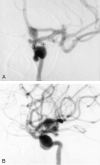Rapid enlargement of a posterior communicating artery aneurysm after Guglielmi detachable coil treatment of ipsilateral carotid artery aneurysms
- PMID: 12372751
- PMCID: PMC7976785
Rapid enlargement of a posterior communicating artery aneurysm after Guglielmi detachable coil treatment of ipsilateral carotid artery aneurysms
Abstract
This case illustrates rapid aneurysm enlargement, presumably due to altered hemodynamics resulting from endovascular treatment of aneurysms on the same artery. We postulate that increased hemodynamic force directed to the inflow zone of the posterior communicating artery aneurysm was caused by the treatment of the two ophthalmic artery aneurysms. Originally, many of the flow vectors may have been directed into the larger ophthalmic segment aneurysm, located on the outside of the curve of the internal carotid artery. After treatment, flow may have been directed more smoothly around the carotid siphon and into the posterior communicating artery aneurysm.
Figures


Similar articles
-
Aneurysm formation after carotid occlusion.AJNR Am J Neuroradiol. 1995 Feb;16(2):329-31. AJNR Am J Neuroradiol. 1995. PMID: 7726081 Free PMC article.
-
[Clinical efficiency of interventional therapy on internal carotid-posterior communicating artery aneurysm].Zhonghua Yi Xue Za Zhi. 2005 Jan 26;85(4):232-4. Zhonghua Yi Xue Za Zhi. 2005. PMID: 15854482 Chinese.
-
Enlargement of a Middle Cerebral Artery Aneurysm after Intra-Aneurysmal Embolization with Parent Artery Preservation for an Ipsilateral Large Internal Carotid Artery Aneurysm: A Case Report.J Stroke Cerebrovasc Dis. 2020 Feb;29(2):104550. doi: 10.1016/j.jstrokecerebrovasdis.2019.104550. Epub 2019 Dec 9. J Stroke Cerebrovasc Dis. 2020. PMID: 31822375
-
Giant cavernous aneurysm associated with trigeminal artery: treatment by detachable balloon.AJNR Am J Neuroradiol. 1987 Sep-Oct;8(5):757-8. AJNR Am J Neuroradiol. 1987. PMID: 3118671 Free PMC article. Review. No abstract available.
-
Flow-Diverter Stent for an Unruptured Aneurysm at the Junction of the Internal Carotid Artery and Persistent Primitive Trigeminal Artery: Case Report and Literature Review.World Neurosurg. 2019 Dec;132:329-332. doi: 10.1016/j.wneu.2019.08.199. Epub 2019 Sep 5. World Neurosurg. 2019. PMID: 31493612 Review.
Cited by
-
The cerebral basal arterial network: morphometry of inflow and outflow components.J Anat. 2017 Jun;230(6):833-841. doi: 10.1111/joa.12604. Epub 2017 Mar 29. J Anat. 2017. PMID: 28370065 Free PMC article.
References
-
- Ferguson GG. Physical factors in the initiation, growth, and rupture of human intracranial saccular aneurysms. J Neurosurg 1972;37:666–677 - PubMed
-
- Misra BK, Whittle IR, Steers AJ, Sellar RJ. De novo saccular aneurysms. Neurosurgery 1988;23:10–15 - PubMed
-
- Stehbens WE. Etiology of intracranial berry aneurysms. J Neurosurg 1989;70:823–831 - PubMed
Publication types
MeSH terms
LinkOut - more resources
Full Text Sources
Medical
